

 The Accurate Reloading Forums
The Accurate Reloading Forums  THE ACCURATE RELOADING.COM FORUMS
THE ACCURATE RELOADING.COM FORUMS  Rifles
Rifles  Medium Bore Rifles
Medium Bore Rifles  Twist rate needed for deep penetration
Twist rate needed for deep penetrationGo  | New  | Find  | Notify  | Tools  | Reply  |  |
One of Us |
For what it is worth, I managed to sort of stabilize a 55gr boat tail spitzer in my 1-in-16 twist 22 hornet! It wasn't all that straight forward. Of relevance though, the penetration of 55gr spitzer soft point flat based bullets in that rifle was not bad at all and bullets tended to stay nose first. Remembering that the bullets mushroomed which is the key to nose first penetration into flesh. The mushroom causes a 'vacuum' to form around the rest of the bullet so destabilizing effects do not apply unless the bullet strikes bone. Regards 303Guy | |||
|
| One of Us |
Joe Read any factual history of the M16 series rifles and you'll see where a number of them (4-5,000) were issued early in the war to the Vietnamese and SF advisors there. Also a number of them were issued to the Air Force and the the Airborne Corp for evaluation. The Air Force and Army found the stabilization problems at the Cold Weather Test Center at Fort Greely, Alaska. I was in the 173rd in '65 and we had a few of them when we deployed to Viet Nam in May '65. These were called "green guns" because the stocks were green. We also had just recieved some EXM16s which did not have the chrome bore or foreward assist. There was a very noticeable difference in wounds caused by both rifles with the same ammo (M193). The only difference was the barrel twist; the green guns had a 14" twist and the EXM16s had a 12" twist. Both rifles had jamming problems because there was no cleaning equipment issued as the space age materials required no maintainence, or so we were told. The EXM16 was quickly standardized as the M16 and was issued in quanity to most all units. Like the 173rd many of the 1st units, including Marines, to Viet Nam had M14s also which gave excellent service. It was the M16s that had all the problems associated with poor maintainence, the powder and poor training. The later M16A1s with chrome bores and forward assists proved to be reliable because the issues and training had been resolved. I saw too many EXM16s and M16s jam, even with scrupulous cleaning, to believe it is all BS as I was there and done that. On a second deployment to SEA in an advisor capacity we had serious jaming problems with new M16s during training which is why I carried an M2 Carbine. It always went bang when I pulled the trigger and when I put the bullet where it belonged PAVN dropped. Also one poster has mentioned the yaw with the slower twists occurs sooner, or something like that. I believe this to be the case based on my comparison of results observed in VC/PAVN and in tests in animals and test media. The complaints coming out of Iraq and Afghanistan regards the same issues of non lethality are real, just as they were in Viet Nam. They also used M193 ammuntion extensively in Iraq (my unit was issued M193 as a basic load there in 2004 and we passed most of it on to the unit that replaced us just like we got it from the unit that we replaced). The iisues were the non lethality from the faster twist and the reduced ballistics of the M4s in common use. Pretty poor marksmanship also is a major factor but generally not mentioned in the complaints. I was comfortable with my M16A2 in Iraq (I turned down M4s on numerous occasions) because it was reliable and accurate with the M193 ammo we had. However, had i really been given my druthers I would have preferred the M14. "Easy to carry" and "handy" don't mean shit to me as long ago I learned the only things that count with a rifle in combat are reliability, accuracy and effectiveness. Larry Gibson | |||
|
| One of Us |
See you described the first rifles that went over accurately. They were green and they were marked as the EX series because they were still in the experimental stage. There weren't that many 14 twist rifles delivered over there. The "Green" rifles should have been marked Colt Armalite AR15 Patent Pending Cal. 223 Model 01. It didn't take them long to realize the 14 twist wasn't stabilizing the FMJ 55 grain boat tailed bullet. Even after the change to the 12 twist the enemy still suffered horrific wounds, but the difference was that most the times the would would be very bad, but some of the times the bullet just passed through the body with little effect. | |||
|
| One of Us |
Seems to me the topic has changed a bit during the thread (or perhaps I misread it oreiginally). I thought the OP's question was if and how twist affected "penetration", NOT wound size. I would observe that depth of penetration is certainly not measured by the size of an exit wound, nor by how severely a target animal (or human) is injured. I'm not saying the info isn't interesting, or that it shouldn't have been posted...just that we seem to be getting a bit afield from collecting documented, proved, facts about how twist influences penetration. A number of the aspects that increase wound size can also work to LIMIT penetration. My country gal's just a moonshiner's daughter, but I love her still. | |||
|
| One of Us |
Well I tried to point damage and penetration out to the Navy ballistic forensic wound doctor by a demonstration. I loaded the Hornady 60 V-Max with one load and fired from both my Colt HBAR with seven twist and my Model 70 Win Heavy barrel varminter with a 12 twist. The only difference is the Model 70 has a 26 inch barrel whereas the Colt HBAR has a twenty, so the velocity was higher out of the Model 70. You would think that would help the bullet blow up more, but read on. The targets were two one gallon milk jugs at 100 yards filled with water. The bullet from the Colt HBAR never made it through the single jub. Pieces of the jacket and lead core were found inside and not larger then a number 4 shot BB. The bullet from the Model 70 went through it. Another test with the milk jugs again was firing a 55 grain Winchester Nam issue FMJ bullet from the same two rifles. In this instance they both went through the jugs of water. The difference is the bullet from the Colt HBAR both shattered and flatten the jug and the one from the Model 70 merely burst and split the back of the jug. These two test clearly show the difference, which the same bullets, from both a 7 and 12 twist and the 12 twist one even had a higher velocity. So to answer the op's original question I would think that the slower twist bullet would penetrate deeper. | |||
|
| one of us |
I think that Iowadon and Smokin J are seeing the effects of increased rotational velocity on a bullet with fairly thin (16/1000th) jacket. A 1-7 or 1-9 vs 1-12 makes a big difference in rotational velocity! Add a deeply imbeded canelure and you get even more fragmentation from the enhanced rv. Rv per second is same as muzzle velocity with a 1-12 twist, and times 1.33 for a 1-9 or times 1.7 for a 1-7 twist. So 3,000 fps = 3,000 rps for a 1-12, 3,990 rps 1-9, and 5,100 rps with 1-7! M855 ammo still breaks in two at cannelure violently most of the time when fired from a 1-7. (Out to about 200 yards). Ive shot goats and gelatin out to 200m with it from 18 and 20 inch rifles and machineguns prior to it being type qualified. A 1-9 will stabilize M855 but you need 1-7 for m856 tracer which is as long as a bad dream. I am surprised that myth is still around (that m855 does not "tumble" or break in two w faster twist). I dont like 14 inch barrels in the black rifle. The M4 has a bad reputation w M855 due to much lower muzzle velocity than 18 inch M249 barrel or 20 inch A2 barrel. I am not surprised by Iowadon's post. Remember that some varmit bullets dont even make it to the target if you push them too fast. That is rv at work. PS I have also seen this in 375 caliber Hornady spire points. They are OK (not great but OK) at 2700 fops in 1-12 but when I shot them at same velocity in my 1-8 they lost alot of weight. Andy | |||
|
| One of Us |
These thin-jacketed brittle (90/10 mix of lead & antimony) unbonbded 'varmint' bullets that are being used in the .223 are frangible bullets to start with, then we have the weakening effect of the engraving through the lands of the barrel to exaccerbate the breakup of the velocity with the extreme high velocity of 3,000 fps exceeding the threshold strength totally for a this genre of bullet to stay together. Bullet break-up has been observed in flight due to faster twist rates such as in the .223 Rem. Warrior | |||
|
| one of us |
I'm only aware of one Bullet which will "Break-Up" at some Velocities available in one specific Caliber. The 0.224" 50gr Speer TNT has a Velocity Limit as stated in the Speer Manuals. Otherwise that same Fragility works to our advantage on Varmints. ----- Just looks like ANOTHER situation where warrior posts partial Truths where he really doesn't understand what is going on. Anyone know of ANY OTHER Bullet that will "Break-Up" in flight simply due to Velocity when shot? And NO, a 45Cal Rifle Bullet WILL NOT Break-Up on an Elk! | |||
|
One of Us |
I know of a few that will break up due to RPMs but not velocity. Hornady's SX .224 caliber and Sierra's blitz in .224 will do so! /////////////////////////////////////////////////////////////////////////// "Socialism is a philosophy of failure, the creed of ignorance, and the gospel of envy, its inherent virtue is the equal sharing of misery." Winston Churchill | |||
|
| One of Us |
Andy, that's the case out of a 20" barrel. They typically don't fragement past 50 yards out of a 14" barrel. | |||
|
| One of Us |
It's a combination of heat (heat from the powder combustion, from the friction of the bullet going down the bore, and friction from air going to the target)velocity, rpm, type of nose construction, and rifling damage that cause a bullet to come apart in the air. With the knowledge of the above would you then think that if the twist is really really fast for the caliber that it may limit the bullets penetration in the target....if it makes it there in one piece? | |||
|
| One of Us |
Hot Core You have still not answered all those questions on Elk when you were called out to do so. When do you plan to give honest answers to those questions - you ran like a coward when challenged. Shame on you. Go back and see that thread where I said that that thin jacketed frangible bullets break up on elk and that includes the .458 caliber. I even posted pics of the bullets that flatenned out. And that is why all ammo companies have come out with stronger bond-core bullets that can better withstand the rigors of impact. So do not skew my comments, and nor do I trash cup and core bullets. In fact I prefer cup an core bullets with controlled expansion like the Swift A-Frame, North Fork, TBBC and Rhino. This is what I don't like:- 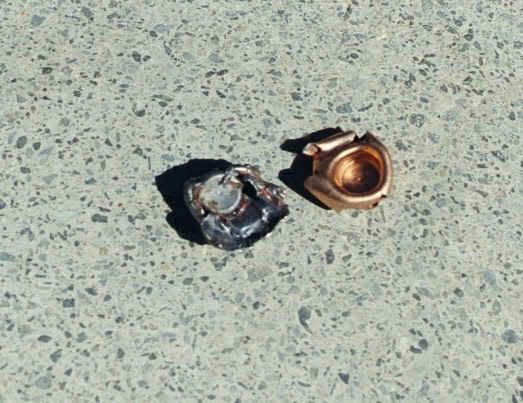 This is what I prefer in bullet performance:- 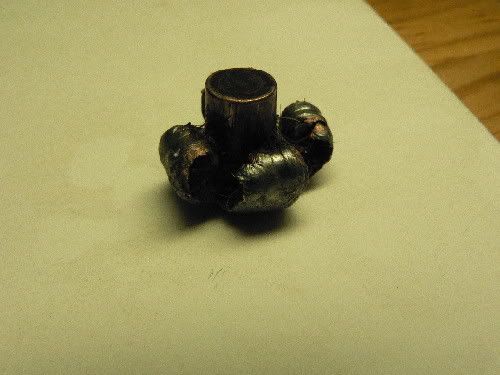 Your posts are always typical to be smart ass. Anyway this thread is not about shooting elk if you paid any attention. Warrior | |||
|
| One of Us |
Cup and core? A Frame cup and core?  NorthFork solid shank cup and core?  TBBC solid shank cup and core? 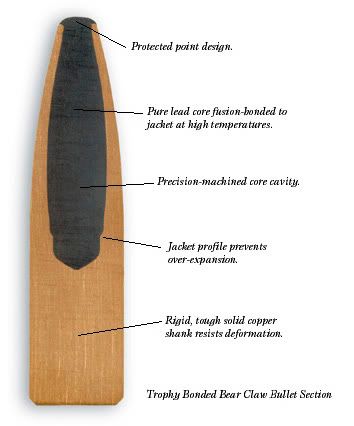 Rhino solid shank cup and core? 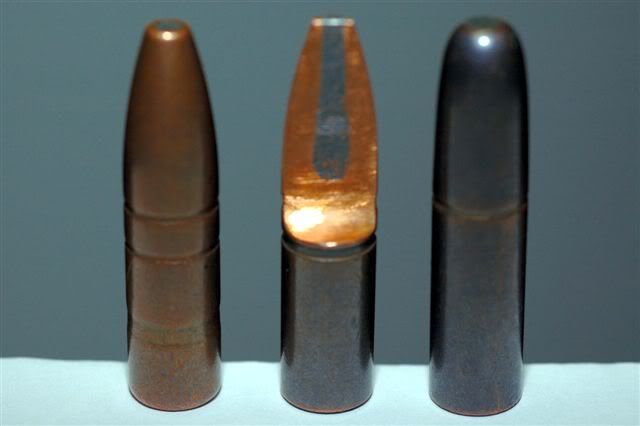 What is a cup and core bullet? Are all bullets cup and core? | |||
|
| One of Us |
What rubbish .... "excellent" lead-core bullets. Hot Core you are speaking the trash !!! This is what I posted above: "These thin-jacketed brittle (90/10 mix of lead 7 antimony) unbonbded 'varmint' bullets that are being used in the .223 are frangible bullets to start with, then we have the weakening effect of the engraving through the lands of the barrel to exaccerbate the breakup of the velocity with the extreme high velocity of 3,000 fps exceeding the threshold strength totally for a this genre of bullet to stay together." Please concentrate .... "thin-jacketed" .... "brittle" .... "unbonbded" They lose weight, fragment and even shatter at high velocity. It is about the relationship of construction to the abuse of high impact velocity as a hunting bullet. These conventional cup & core bullets are NOT EXCELLENT. period !!! Warrior | |||
|
| One of Us |
The following array of hunting bullets may in fact be of assistance to to guide us to the more EXCELLENT if that is the term that is being used, but more so to contrast the frail bullets that lose their CORES to shatter with shallow penetration as a result. It is all about choices today and the application of a particular type of bullet - here we talk about a bullet to hunt game with - not target shooting or the shooting of varmints.  Warrior | |||
|
| one of us |
I don't believe I've ever tried either of them. But, I'll be glad to take your word on it. ----- How many folks believe the fist flick(or ANY OF THEM) warrior put up - actually came apart on an Elk? ---- But, this is about Twist Rate, so how many believe the first flick warrior posted(or ANY OF THEM) shows a 45cal Rifle Bullet which came apart due to Twist? It would be the same amount as the first question - ZERO! | |||
|
| One of Us |
Frangible bullets come apart mainly due to the force of momentum and high energy driven by velocity that impacts at a level too high for the bullet's threshold strength. The more frail and frangible the bullet, the easier it fragments and shatters. An unnecessary faster twist, albeit at a much lower scale, is not helping either for a slower set-up of an already frail bullet being thin-jacketed, unbonded and a brittle lead mix of 90% lead and 10% antimony. These old fashioned conventional bullets perform well at impact velocities of 2,000 fps, as demonstrated by various tests, but as impact velocities go up they soon reach their limit, and so we get jacket and core separation and fragmentation results. They do their best work at range once the bullet has slowed down by keeping the bullet within its threshold strength. Big-bore bullets that carry higher momentum and energy values ought to have thicker jacks to cope. And the bonding process requires a change to pure copper and pure lead, so that both metals flow together better in the expansion process on impact. Here is a typical example of the SA Claw bullet - a bonded bullet very similar the Hawk bullet made in the USA:- 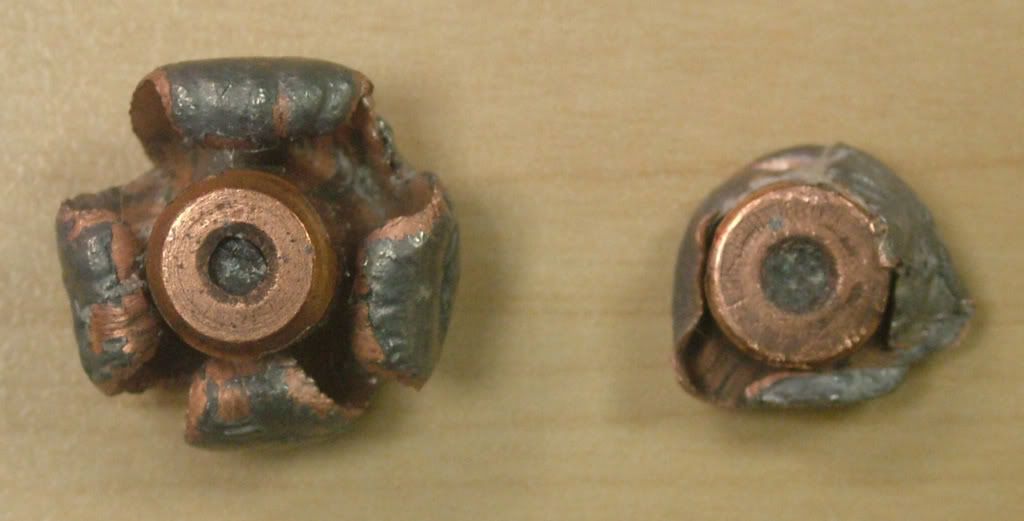 They are 9,3 mm bullets - on the left we have a bullet with 2 mm jackets and on the right only 1 mm. Their respective weight retention ratios are 98.6% and 41.7% Bullet performance differ drastically. Warrior | |||
|
| One of Us |
just to get it said, for many, many years in history and continuing today, hunters have killed stuff with lead bullets, just lead. While it doesn't look as kewl as the perfect mushrooms you see in the ads and it is something the "purist" (if that's the proper term) can whine about, a seperation of jacket and core is not the disaster some folks would have you believe. It's a sort of variation of the old "at what point in the dead animal did the bullet fail?" FWIW, using a 22-250, I've driven the tnt and sx bullets to where they failed. All you get on the target is several tiny holes like from #9 shot. Aim for the exit hole | |||
|
| One of Us |
The fact that frail conventional bullets can kill, and have killed, is not in dispute. It is about options we have today that we did not have in years gone by. The limitations imposed by its use is no longer our only option. We have had a bullet revolution during the last decade. For example: Remington developed and re-designed their Core-Lokt bullet, and now offer a superior product to discerning hunters - it is called the Core-Lokt Ultra Bonded. Being a bonded bullet, it affords much better weight retention than conventional lead-core bullets. The Core-Lokt Ultra Bonded features a progressively tapered jacket design, which better controls expansion to 1.8 times of original diameter. Clearly Remington identified this need to offer a better hunting bullet, combining the 3 aspects that need to be balanced - an expanding bullet to form and keep its mushroom shape, affording deep penetration through adequate weight retention and a bullet that does not over expand to inhibit penetration. Bullets are all about a balance between integrity, expansion and penetration. The 458 family of Magnums was actually designed for large dangerous game in Africa, and as such a conventional bullet is actually a mismatch for these powerful calibers. To penetrate deep on large game, a bullet has to stay together rather than to fragment or even disintegrate. Some however do use frangible conventional bullets in these calibers. Here is an example of a thin-jacketed, non bonded, conventional lead-core bullet with an exposed lead tip - a sectioned picture of the .458/510 gr Winchester Super-X SP can be seen here: http://www.winchester.com/Prod...t/Pages/default.aspx Hornady's version of the conventional bullet is the 500 gr Interlock Soft Point bullet (still a frail bullet), which has just recently been superseded by a much tougher bullet; the DGX bullet that expands in a controlled way; a wise move by Hornady. Warrior | |||
|
| one of us |
| |||
|
One of Us |
Not a chance....,it's RPMs! /////////////////////////////////////////////////////////////////////////// "Socialism is a philosophy of failure, the creed of ignorance, and the gospel of envy, its inherent virtue is the equal sharing of misery." Winston Churchill | |||
|
| One of Us |
I agree! However I see a growing philosophy that some sort of magic bullet can absolve you of any responsibility of shot placement or markmanship. And too, as the knowledge base grew, the makers of standard bullets haven't been sitting on their hands. I think the garden variety of C&C bullets have improved with better knowledge of jacket material and construction and better core mixes. Aim for the exit hole | |||
|
| one of us |
. | |||
|
| One of Us |
Warrior | |||
|
| One of Us |
It is obvious you believe what you say. What you don't seem to recognize however is that a great many of us don't find high velocities necessary to kill game animals, and for us cup 'n core bullets work just fine. So, in our applications, bonded and mono metal bullets aren't a bit better. They ARE more expensive and perhaps appeal more to those (not necessarily including you) who base their individual status rankings on using the most current technology (fads sometimes?) whether needed or not. That's okay, it is a free world (in some areas). But it seems perhaps a bit much to trash talk perfectly good products because you may choose to use them at velocities for which they are not intended, and which for many of us are velocities that are totally unneccesary in our own hunting. My country gal's just a moonshiner's daughter, but I love her still. | |||
|
| one of us |
. | |||
|
One of Us |
Surely the Rhino and others shown would not be classed as 'cup & core'? Bonded cores might have an identical 'cup' but if the core is bonded by soldering or whatever then it's no longer a 'cup & core', surely? Regards 303Guy | |||
|
| One of Us |
303Guy, You are right, the original old-style conventional lead-core bullets were referrred to as cup & core bullets, as they consisted of two metals; a gilding metal jacket that was drawn from a disk to form an elongated cup and a lead-mix core was inserted and then swaged. However today we run in a bit of a problem with categorization to uniquely describe each genre of bulle, as we had such a proliferation in bullet construction types. 1) Bullets resembling a cup & a core: Conventional bullet - No interlock mechanism Conventional bullet - Interlock mechanism Conventional bullet - Dual lead-core Conventional bullet - Hot core process (not bonded) Bonded bullets - thin-jacketed Bonded bullets - thick-jacketed Bonded bullets - taper-jacketed (thicker towards the base) Bonded bullets - with partition (non bonded) Bonded bullets - with partition (bonded) All the above bullets are very different but I listed them under one umbrella, and perhaps they should not. 2) Bullets with a solid shank & a lead core (front piece resemble a cup): TBBC Rhino Northfork Again, these bullets are very different from the first category, and at the same time they differ individually in many respects as well. Some sectioned bullets with a mono-metal chucked in as well: 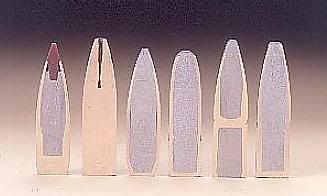 Even amongst the modified or enhanced type of conventional bullets we have differences, as we can see in the Speer Grand Slam: A dual-core bullet, the Grand Slam has a hard lead heel (5% antimony instead of 10%) held by an internal jacket lip. The nose core is softer, for quick upset. Grand Slam jackets are four percent thicker than those on Speer's Hot-Cor bullets. The PMP Pro-Amm bullet is much the same. Then some further developments to complicate our categorization: Federal's Fusion bullets are plated and so are Speer's Deep Curl - no cup in the true traditional sense of the word. Warrior | |||
|
| one of us |
And doing the Tally of those who believe warrior(from the above questions) is - Taa Daaaa - Zero, Nada, Zilch, Goose Egg, Not-a-One Un-fortunately alf is here to Dumb-it-down for all of us(while trying to work Human Wounds into a thread where it is not needed nor wanted). | |||
|
| One of Us |
Hot Core, You have not added one bit of useful information here whatsoever. Your role is simply to styfle discussions and ridicule individuals. What is wrong with you ... you seem like a you were brought up as a spoilt brat. Why do you have to denigrate and mock Alf for ever and a day? If you cannot add something of value here, why make such an asshole of yourself? It is clear for all to see what you do here. How pitiful and disgraceful. Warrior | |||
|
| One of Us |
Alberta Canuck, We really need to see the introduction of the old-style conventional bullets in its time frame. This means we need to consider the change over from Black Powder to Nitro to Smokeless Powder, and the calibers that existed in the same time period that was in use. The proliferation of cartridges really only started with Roy Weatherby in the mid-forties and with other wildcat experiments by P.O. Ackley and others that followed. This bullet design is basically the same as 100 years ago and velocities way back then were fairly modest. Captain Rubin of the Swiss Army invented jacketed bullets in 1889. During the Spanish War of 1898 and the second Anglo Boer War of 1899, the 7 x 57 mm Mauser came into its own by shooting at a much higher velocity, offering the soldier a flatter trajectory than the opposition. The 303 Br was doing 2,050 fps, the 7.9 mm Mauser was doing 2,100 fps whilst the 30-40 Krag could do 2,150 fps. The 7 x 57 mm Mauser was considered fast at 2,300 fps and out performed its rivals. Consider now the down range velocity, and it becomes clear why these conventional cup and core bullets performed well. Generally, these conventional bullets worked well for impact velocities between 1,900 and 2,100 fps. I consider conventional bullets as largely outdated, with our faster cartridges of today, and they are not meant for impact velocities higher than 2,100 fps as they are too 'fragile' as a hunting bullet. However, if they are used sensibly, they work fine. For example, a 30-06 Spr with a muzzle velocity of 2,625 fps will do about 2,050 fps at 250 yards at which distance the bullet will do its best work. PMP’s ProAmm, supposedly a notch up on a conventional bullet, is not really a premium grade bullet in my opinion. This bullet cannot withstand high velocities. Johan Piennaar of Liberty Life shot 7 Springbok last season in Keetmanshoop with this bullet using his 7 mm Rem Mag, loaded to 2,756 fps (Standard PMP velocity). All bullets blew up, not a single exit hole and 4 out of the 7 Springbok required second shots. All shots were smack on the vital area and the average distance was about 200 yds, which meant that the bullets had time to slow down to a striking velocity of 2,324 fps. Still, the meat was messed up due to bullet fragmentation. This is not for the connoisseur. Abrie Arlow, used his 270 Win (130 gr PMP ProAmm @ 2,756 fps) to shoot a Damara Sheep in Douglas with equally bad results. The sheep was shot in the chest from the front - the bullet also shattered completely. Warrior | |||
|
| One of Us |
Warrior - I am not trying to convince you. You are a true believer in the new stuff and will not allow yourself to be convinced the old stuff is still good, regardless. But, the older style bullets have worked extremely well for me (and a lot of other folks here at AR), and still do. I do not have to look at them in terms of super-velocity modern cartridges. (I really have little daily need for those cartridges either.) The C 'n Cs work extremely well for me from rifles which commonly propel their bullets from the muzzle at up to 2,800 f.p.s. or slightly more. That is ALL I need for my hunting. For below 2,200 fps, I don't even need JACKETED bullets. Gas-checked cast bullets work fine up to there or even a couple of hundred fps faster. My style of hunting is to enjoy the HUNT...to enjoy pitting my hunting, finding, and stalking skills against animals so I can get to within 200 yards of them, usually much less than that. Could I do that every time out if I was a weekends-only hunter? Well, perhaps not, but that is irrelevant because it is the hunt I enjoy, not just the killing of an animal. So I don't have to kill every time out to enjoy hunting. And I don't need to kill a deer or an elk every time out to eat regularly. I HAVE killed a lot of elk-sized animals at ranges far enough away that if my employer (by proxy, the State) hadn't required me to shoot at them, I wouldn't have. But the C 'n C bullets still killed very well and dependably. And,THAT was what counted...not whether they stayed intact or looked like they could be re-shot afterward, that sort of stuff. They penetrated enough and destroyed enough tissue to kill reliably. And they were accurate enough to be placed correctly into the animal. That isn't saying that mono bullets or bonded bullets are not good hunting bullets too. They are. But so are C 'n C bullets. And will be tomorrow and the decades after that. In the meantime, we can all say here which ones we prefer, and why, and continue to exercise our preferences without having to trash the ones we don't pick for ourselves. Best wishes, regardless. AC My country gal's just a moonshiner's daughter, but I love her still. | |||
|
| One of Us |
In my posts above I mentioned that it is not about the killing per se, and whether or not a bullet can kill, but rather what the 'green band' of the bullet is in terms of: - its propensity to retain its weight or shattering - its expanding charateristics - its penetration potential It is really just a matter of accepting the limitations of a certain class of bullets, regardless of which bullet it is. It is not just conventional bullets that have severe limitations at high impact velocities ito shattering , but many bonded bullets suffer over expansion when the velocity goes too high. So it is application .... when kept in its 'green band' the performance is sterling. Hence forth it is about choices (or more flexible choices) that we can make as to which hunting bullet we opt for, and we have an array of bullet types to choose from. Here is a classical example of the crital role of impact velocity - shot at 3,000 fps vs 2,000 fps. 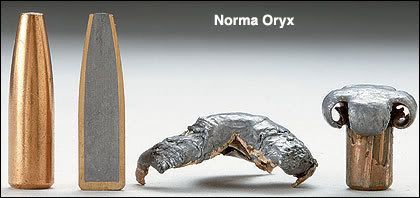 This bullet's green band is at the lower end deteriorate quickly as we move up to 3,000 fps. I have tried this bullet and it must be the softest thin-jacketed bonded bullet out there. Used in calibers such as 6.5x55 and 7x57, it will do its best work - not in a 300 Win Mag @ 3000 fps. So it is not about trashing 'good' bullets, but rather accepting them for what they are, and applying them in their respective 'green bands'. Warrior | |||
|
| One of Us |
You have that the wrong way round; 10% antimony/lead alloy is harder than 5% alloy. | |||
|
| One of Us |
Oddbod, Quite correct. Thanks for the correction. I brought 200 Grand Slams in from the US during 1998 for my 300 H&H. However the dual core is appantaly no longer offered, I came across the following: "Used to have a two-part core. Soft in the front, hard in the back, separated by an interlock on steroids. Not a full partition but a large skived ring of jacket material between the two. They did away with the two-part core and the ring but added a small heel fold. So now it's no more than a Mag-Tip with a heel fold. Not a condemnation of the Mag-Tip but of ATK's decision to turn the Grand Slam into a non-premium yet still charge a premium price." .... Whttail in MT Warrior | |||
|
| One of Us |
With that, I can agree. And it goes for ALL bullets, not just C 'n Cs or just mono bullets, or just any other category...to the extent they CAN be categorized these days. (And, also to the extent those results are proved by real-life performance on game of the type being hunted, whether very thin skinned, thin-skinned, heavy skinned, small boned, large boned, etc. Advertising hype not withstanding). So, with that clearly out of the way, I can say again that FOR MY TYPE OF HUNTING and the rifles I commonly use to hunt with, C 'n C bullets are my preference because 1. They do the job well for me. 2. They are relatively inexpensive to buy and use. 3. They are available pretty much everywhere that handloading is legal. 4. Because they are inexpensive, I can practice a lot with my rifles, using the same bullets I use in the field. That actually improves their effectiveness on game relative to bullets which I could afford to shoot less often and thereby have less of a feel developed for their downrange trajectories, etc. In a poll on another forum here, it turns out that at least through yesterday, 51% of the over 100 actually voting respondents here at AR feel the same way about using C 'n Cs for their hunting. My country gal's just a moonshiner's daughter, but I love her still. | |||
|
| Powered by Social Strata | Page 1 2 |
| Please Wait. Your request is being processed... |
|
 The Accurate Reloading Forums
The Accurate Reloading Forums  THE ACCURATE RELOADING.COM FORUMS
THE ACCURATE RELOADING.COM FORUMS  Rifles
Rifles  Medium Bore Rifles
Medium Bore Rifles  Twist rate needed for deep penetration
Twist rate needed for deep penetration

Visit our on-line store for AR Memorabilia

